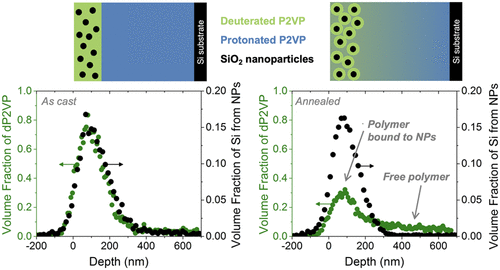当前位置:
X-MOL 学术
›
Macromolecules
›
论文详情
Our official English website, www.x-mol.net, welcomes your
feedback! (Note: you will need to create a separate account there.)
Characterizing the Areal Density and Desorption Kinetics of Physically Adsorbed Polymer in Polymer Nanocomposite Melts
Macromolecules ( IF 5.1 ) Pub Date : 2020-03-24 , DOI: 10.1021/acs.macromol.9b02205 Eric J. Bailey 1 , Philip J. Griffin 1 , Russell J. Composto 1 , Karen I. Winey 1
Macromolecules ( IF 5.1 ) Pub Date : 2020-03-24 , DOI: 10.1021/acs.macromol.9b02205 Eric J. Bailey 1 , Philip J. Griffin 1 , Russell J. Composto 1 , Karen I. Winey 1
Affiliation

|
The interfacial regions between nanoparticles (NPs) and polymers in polymer nanocomposites (PNCs) underlie enhanced properties, and the temporal stability of these bound polymer layers is necessary for extended control on PNC performance. Using ion scattering techniques and poly(2-vinyl pyridine) (P2VP) mixed with 26 nm silica NPs, we investigate the lifetime of the bound polymer layer by separating and directly measuring the fraction of free polymer and polymer adsorbed to attractive NPs entirely in the melt state. By annealing thin PNC films deposited on bulk polymer matrices, free polymer from the PNC rapidly diffuses into the underlying matrix while the spontaneously formed bound polymer in the melt remains with the NPs. By correlating the fraction of bound chains with the NP surface area, our analysis shows that bound polymer chains extend ∼Rg from the NP surface into the melt. The calculated average NP surface area occupied by adsorbed chains in the melt is much smaller than predicted for an isolated chain or measured in an NP–polymer solution. The bound polymer fraction decreases as a function of annealing time and decreases more rapidly at higher temperatures and for lower molecular weights. This work demonstrates that ion scattering methods can quantitatively measure the chain-scale structure and dynamics of polymers bound to NPs in the melt state. This new information provides fundamental insights and enables the design of PNCs with greater thermal stability during fabrication and use.
中文翻译:

表征聚合物纳米复合熔体中物理吸附聚合物的面密度和解吸动力学
纳米粒子(NPs)与聚合物纳米复合材料(PNCs)中的聚合物之间的界面区域具有增强的性能,而这些结合的聚合物层的时间稳定性对于扩展控制PNC性能是必需的。使用离子散射技术和与26 nm二氧化硅NP混合的聚(2-乙烯基吡啶)(P2VP),我们通过分离并直接测量游离聚合物和完全吸附在有吸引力NP中的聚合物的比例来研究结合的聚合物层的寿命。熔化状态。通过退火沉积在本体聚合物基质上的薄PNC薄膜,来自PNC的游离聚合物迅速扩散到下面的基质中,而熔体中自发形成的结合聚合物则保留在NP中。通过将结合链的分数与NP表面积相关联,我们的分析表明,结合的聚合物链延伸〜R g从NP表面进入熔体。计算得出的熔体中吸附链所占据的平均NP表面积要比孤立链预测的或在NP-聚合物溶液中测得的平均表面积小得多。结合的聚合物分数作为退火时间的函数而降低,并且在较高温度和较低分子量下降低得更快。这项工作表明,离子散射方法可以定量测量熔融态下与NPs结合的聚合物的链级结构和动力学。这些新信息提供了基本的见识,并使PNC的设计在制造和使用过程中具有更高的热稳定性。
更新日期:2020-04-24
中文翻译:

表征聚合物纳米复合熔体中物理吸附聚合物的面密度和解吸动力学
纳米粒子(NPs)与聚合物纳米复合材料(PNCs)中的聚合物之间的界面区域具有增强的性能,而这些结合的聚合物层的时间稳定性对于扩展控制PNC性能是必需的。使用离子散射技术和与26 nm二氧化硅NP混合的聚(2-乙烯基吡啶)(P2VP),我们通过分离并直接测量游离聚合物和完全吸附在有吸引力NP中的聚合物的比例来研究结合的聚合物层的寿命。熔化状态。通过退火沉积在本体聚合物基质上的薄PNC薄膜,来自PNC的游离聚合物迅速扩散到下面的基质中,而熔体中自发形成的结合聚合物则保留在NP中。通过将结合链的分数与NP表面积相关联,我们的分析表明,结合的聚合物链延伸〜R g从NP表面进入熔体。计算得出的熔体中吸附链所占据的平均NP表面积要比孤立链预测的或在NP-聚合物溶液中测得的平均表面积小得多。结合的聚合物分数作为退火时间的函数而降低,并且在较高温度和较低分子量下降低得更快。这项工作表明,离子散射方法可以定量测量熔融态下与NPs结合的聚合物的链级结构和动力学。这些新信息提供了基本的见识,并使PNC的设计在制造和使用过程中具有更高的热稳定性。











































 京公网安备 11010802027423号
京公网安备 11010802027423号